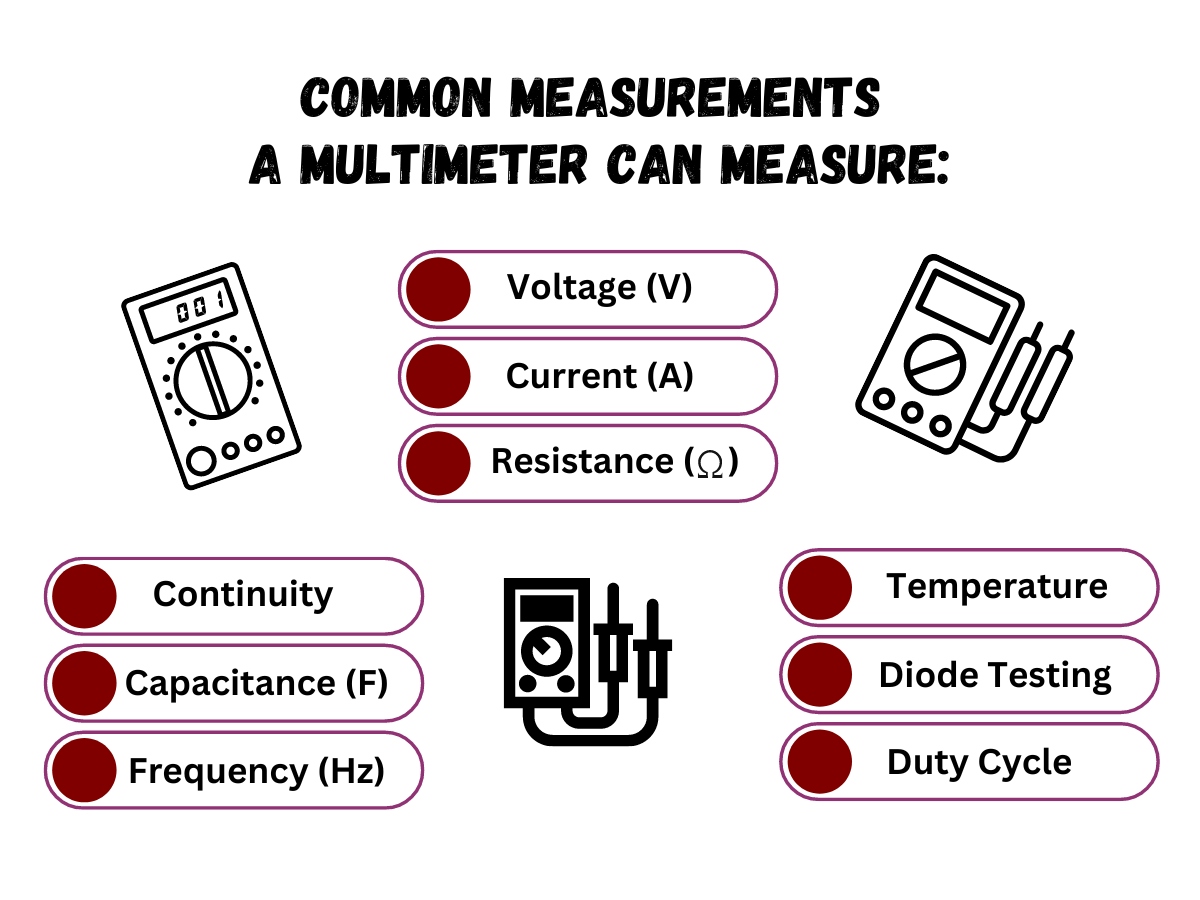What Does a Multimeter Measure?
The Definitive Guide To Using Multimeters
What Does a Multimeter Measure?
A multimeter measures common electrical measurements, most notably voltage (volts), current (amps) and resistance (ohms). Many multimeters add additional measurement capabilities such as capacitance and frequency.
Multimeters are essential tools used to measure a range of electrical parameters, providing insights into the behavior of electronic systems. They quantify values like voltage, current, resistance, capacitance, and frequency, offering a comprehensive understanding of circuit performance.
Because of this wide range of functionality contained in a singular device, these versatile instruments play a pivotal role in all areas of electronics. Rather than needing to carry three or more tools to get the job done, the multimeter can cover nearly all facets of basic electronics measurement.
the Definitive Guide to Using Multimeters
This is the third article in our series, The Definitive Guide to Using Multimeters.
This article discusses the numerous types of measurements the multimeter can perform.
In This Article
If you missed the start of the series: What Is a Multimeter: The Definitive Guide to Multimeters, check it out now! You will be able to work your way back to this article quite quickly.
The Definitive Guide to Multimeters
- What is a Multimeter?
- Why Are Multimeters Important?
- What Do Multimeters Measure?
- What is the History of the Multimeter?
- What are the Common Types of Multimeters?
- What are Common Multimeter Options?
- What are Some Multimeter Specifications?
- What are Common Uses of Multimeters?
- How Do I Choose the Best Multimeter For The Job?
- How Do I Use a Multimeter?
- How Do I Properly Maintain a Multimeter?
- How Do I Calibrate a Multimeter?
- What is the Future of Multimeters?
- Multimeter FAQs
Basic Multimeter Measurements
Although multimeters can measure numerous electrical quantities, most of these quantities are on the more basic end of electrical measurement.
The most basic of those measurements revolve around Ohm's Law. If you recall back to Physics class in high school, Ohm's law dictates the relationship between the three building blocks of electricity, voltage, current and resistance.

Ohm's Law - Basic Multimeter Measurements
Essentially all multimeters are able to measure these core electrical parameters:
Voltage (V)
Multimeters can measure both direct (DC) voltage and alternating (AC) voltage. They are used to measure the voltage across a component or a circuit.
Current (A)
Multimeters can measure both DC current and AC current. They are used to measure the flow of electric current through a circuit or component.
Resistance (Ω)
Multimeters can measure resistance, which is the opposition to the flow of electric current. They are used to measure the resistance of resistors, conductors, or other components.
Although it doesn't fit neatly into Ohm's law, one more very common measurement most multimeters perform is continuity:
Continuity
Multimeters have a continuity function that checks whether there is a complete path for the electric current flow. It is used to determine if a circuit or connection is open or closed.
Continuity is really more of a functional test than a measurement, as it does not return an actual value. Most multimeters simply return an audible noise confirming the presence of a complete path.
Advanced Multimeter Measurements
Of course, over time, the drive to pack even more functionality into this universal testing device led to rapid advancement in what a multimeter can measure.
Many of these additional measurement parameters are commonplace on multimeters today:
Capacitance (F)
Some multimeters can measure capacitance, which is the ability of a component to store electrical charge. It is used to measure the capacitance of capacitors.
Frequency (Hz)
Advanced multimeters can measure the frequency of an alternating current signal. This is useful for analyzing signals in electronics or troubleshooting.
Temperature (°C or °F)
Certain multimeters have a temperature measurement function, allowing them to measure temperature using a thermocouple or a temperature probe.
Diode Testing
Some multimeters have a diode testing function that checks the directional voltage drop of diodes and verifies their functionality.
Duty Cycle
This measurement is often used in digital circuits to determine the ratio of time a signal is high (ON) compared to the total time of one cycle.
Summary
As we have seen, the multimeter is an incredibly diverse instrument that can measure nearly every facet of basic electrical measurements.
The most common measurements a multimeter can measure are:
- Voltage (V)
- Current (A)
- Resistance (Ω)
- Continuity
- Capacitance (F)
- Frequency (Hz)
- Temperature (°C or °F)
- Diode Testing
- Duty Cycle

What's Next: The Definitive Guide to Multimeters
Now that we know the common measurements a multimeter can make, let's start diving into some of the most common types of multimeters.
In the next section, we will dive into the original type of multimeter: the Analog Multimeters (that we briefly discussed above). Lets get started and head to Section 3: Analog Multimeters.
ISO/IEC 17025 Accredited Multimeter Calibration
Fox Valley Metrology proudly offers accredited precision measuring instrument calibration services of Multimeters. We calibrate all types of Multimeters at our offices throughout the country, meaning we are sure to have local Multimeter calibration services near you.
- ✓ ISO 17025 accredited calibration vendor
- ✓ Broadest calibration scope in the industry
- ✓ 3-5 day turnaround time for laboratory calibrations
- ✓ Pickup and delivery service options available
- ✓ Onsite calibrating service options